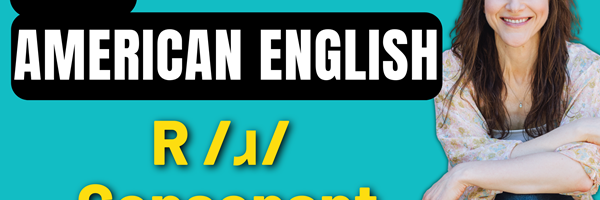(Video Transcript)
Get ready to boost your English pronunciation with this four-part series on how to speak English with ease.
Imagine if you can, what smooth, connected, easy English sounds like. Can you hear it? Can you imagine how syllables and words just blend together easily and effortlessly?
Great - keep that auditory memory in your mind.
Now I want you to imagine what the opposite sounds like. What does English sound like when it’s halting, disconnected, and effortful? What is it that stops the flow of English, that gets in the way of this smooth, easy, connected sound?
There could be many things that stop the flow of someone’s spoken English, but one of the main culprits is stop consonants. And specifically, the true T sound.
The True T /t/ Sound in English
Now, the True T
T, T, T, T,
is not bad or incorrect, and in many words, the T consonant should be pronounced like a True T, like in the words Tuesday, attach, and storm.
But many times, the pronunciation of the T sound changes in spoken English, and if you don’t know when to change the T to a different sound, then your speech might not be as smooth and connected as it could be.
The True T sound has some extra movements to it,
T, T, T,
and it usually has that puff of air that comes out as you say it, called aspiration.
Tuesday
Tuesday
Meet me on Tuesday.
T, T, Tuesday
So sometimes the True T takes a little extra effort to say, and it can have that built-in aspiration that sort of disrupts the flow of speech.
When non-native speakers use the true T in places where it should be a different T sound, that’s when I hear their speech sound effortful or disconnected.
But American English favors the opposite. American English favors flow and connection of words and syllables, and stop consonants like the True T sound can disrupt this flow. That’s why the stop consonants, and specifically the T consonant, change to a different pronunciation - so that speech can be faster and more connected.
This is one way that native speakers sound so smooth when they speak. They are changing the T pronunciation to something else, something that’s faster and easier to say.
And this video will teach you the first way that the T sound changes in spoken English.
Learn this rule, and you’ll be on your way to speaking English with ease.
The Flap T /ɾ/ Sound in English
If there’s one sound that defines the American accent, it’s gotta be the flap. The flap is in words like water and butter. These words are spelled with a letter T, but they’re not usually pronounced with a T sound. Other forms of English may use a true T sound in water, but in American English, it’s water, with a flap.
You might know these words already - water, butter, yep, you’ve got those down perfectly. But the flap occurs in lots of places in English, especially in phrases and sentences, and if you want to speak English with ease, you must start here with the flap.
How to Pronounce the Flap T /ɾ/
The flap is made by quickly flapping the tongue tip against the bumpy ridge just behind the front teeth. That place is called the alveolar ridge, and it’s at the very front of the roof of the mouth. When you pronounce a flap, you don’t really stop the airflow. The tongue tip just shapes the air as it exits the mouth.
The rules of the flap apply to both the T and the D consonants - both of these stop consonants typically become the flap when they are between vowels in unstressed syllables.
So both letter and ladder have the flap, even though letter is spelled with the letter T and ladder is spelled with the letter D. Both words are pronounced with flaps because the T and D are between vowels, like you see here in the IPA transcriptions.
The flap is fast. If you go too slowly, it will sound like a D consonant, and it is similar to a D consonant - they are both voiced, and the tongue tip touches the same place in the mouth for the flap and the D - but the flap is quicker, where the D is a true stop consonant, where the airflow is stopped and then released.
The flap also only occurs between vowels in spoken English, either within a word like water or between words like the phrase “it is”.
Wait, stop! This isn’t exactly true. Ok, it’s true that the flap occurs between vowels, nearly always, but it sometimes violates this rule, which is really frustrating! Native speakers may also use the flap in a word like seventy, seventy, dee, dee, that T usually becomes a flap, not a true T. And for some native speakers, the flap also occurs in the word doctor, doctor, der, der. That T is sometimes pronounced like a flap.
In summary, the flap is almost always between vowels, but it can violate this rule and show up in words where you’d least expect it!
Now back to the video.
It always has to be linked to another sound, and that’s why it’s so common in conversational English because it is used a lot when linking words together.
The Flap /ɾ/ in American English Verbs
And here’s a really interesting thing about the flap. You have lots of opportunities to use it in the pronunciation of verbs that end in -ed and -ing, where the root infinitive form of the verb ends in a T or D.
Why? Because when you add the -ed or -ing ending to these root verbs, you’re attaching a syllable that begins with a vowel. This may put that final T or D between vowels, and now you have the opportunity to change that T or D to a flap.
This happens in a word like
Dating
The root word is “date”, and that ends in a T consonant. When I add the -ing ending, the T is between vowels - the AY vowel and the IH vowel. You’ll notice that when these syllables link together, the T moves over to the beginning of the next syllable. The T now begins that unstressed syllable, “ting”, and it switches to the flap.
"day-ding"
dating
Just listen to how quickly the flap is used in conversational English. Pay attention because these speakers say it really fast:
Target words in the videos: little, daughter, city, leader, a lot of, it is, put it, made of
Flap /ɾ/ Pronunciation in American English: Practice
Let’s practice a few words and phrases that contain the flap, up close and in slow motion. You’ll hear each word or phrase three times to help train your ears to hear the flap, then you’ll have a chance to imitate in the pauses.
5 words:
Party
Community
Leadership
dating
excited
3 phrases:
I have a lot of homework.
What’s this table made of?
What is this?
Looking for more flap practice? I’ve got you covered! You can practice the flap with me in English Pro, my comprehensive online American accent training program, where you’ll have access to hundreds of practice videos and audio recordings that practice the flap sound in words, phrases, and sentences. Check out the description below for the link to learn more about English Pro, and how we can work together during a live English class.
Or you can become a member of my YouTube channel by clicking the Join button below. All members have immediate access to practice videos that are exclusive to members of my YouTube channel, and you can start practicing right now. This is a great way to support my channel, and it helps me to continue providing you with free, awesome, English pronunciation lessons. So click on the Join button below and select the membership level that’s best for you.
If you liked this video and found it helpful, then please click the like button and subscribe to my channel with notifications turned on, so you don’t miss any of my free English lessons. This really helps other people to find me in the giant world of YouTube.
Thanks so much for watching, and I hope you have a great day!



